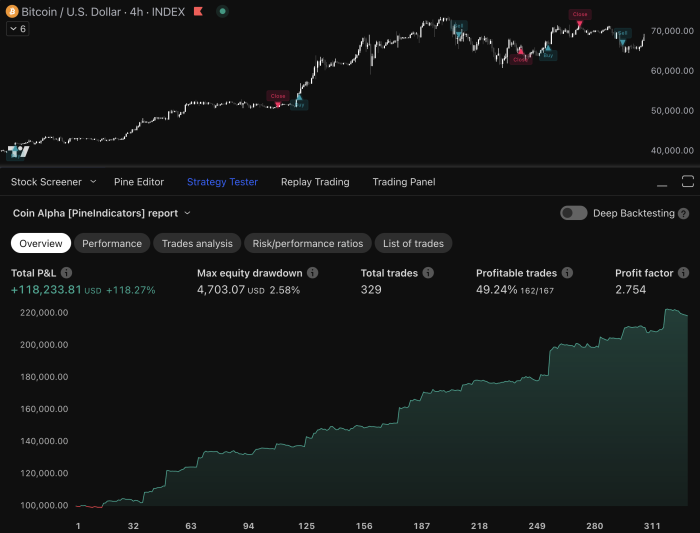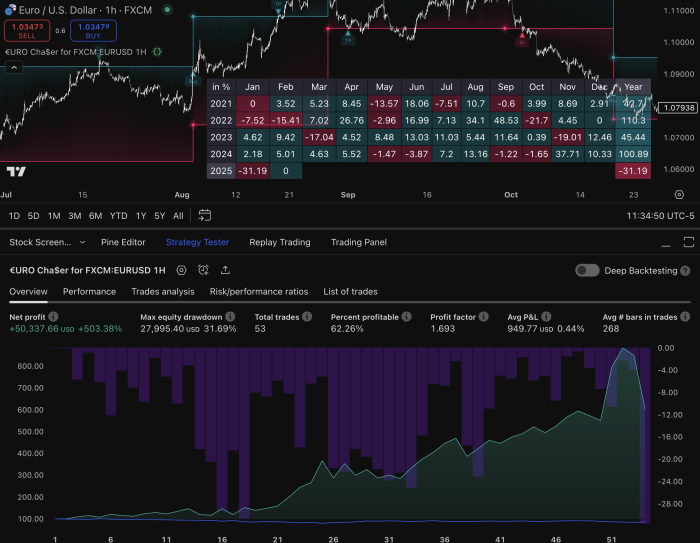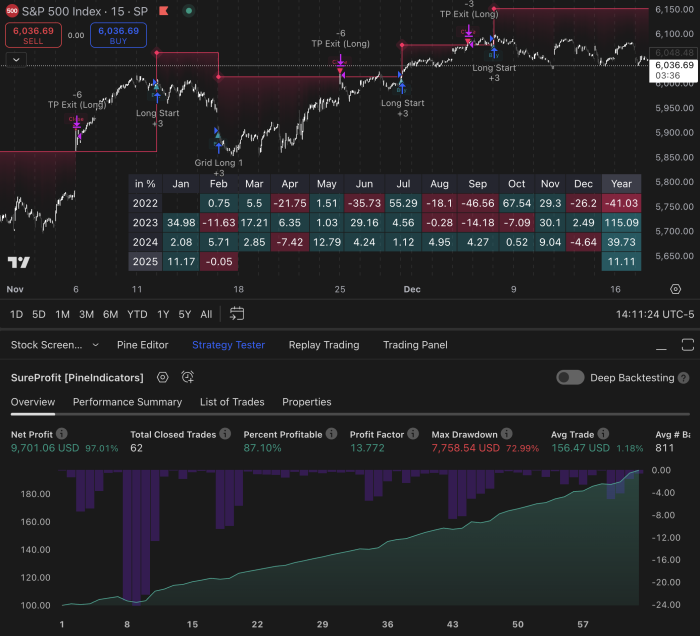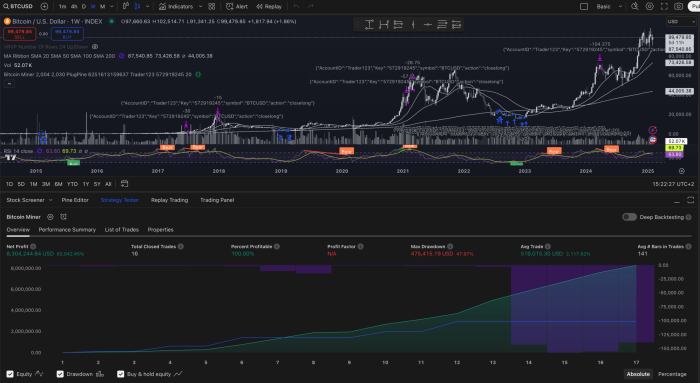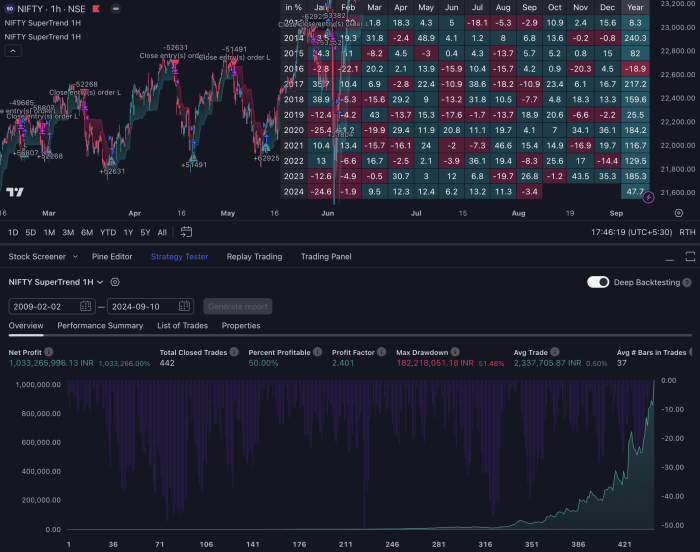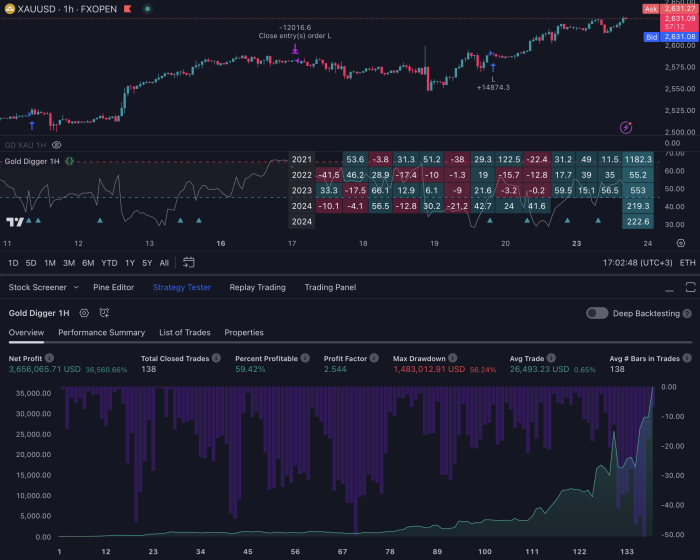How to Design a Profitable Trading System
A profitable trading system is the foundation of successful trading. Without a well-designed system, you’re essentially gambling with your money in the markets. A trading system provides structure, consistency, and a clear path to achieving your financial goals.
Your trading system acts as your personal guide in the markets – it defines your entry points, exit strategies, risk parameters, and position sizing rules. These elements work together to create a framework that can potentially generate consistent profits while protecting your capital.
At PineIndicators.com, you’ll find proven trading strategies and tools designed specifically for TradingView users. These resources can help you build, test, and refine your own profitable trading system. Whether you’re looking for advanced Pine Script tutorials to enhance your coding skills, or seeking Pine Script templates to streamline your strategy development, we have you covered.
If you’re interested in the Forex market, our Forex indicator scripts for TradingView can provide valuable insights. Alternatively, if cryptocurrencies are more your focus, our buy crypto strategies for TradingView can offer effective solutions tailored to this dynamic market.
Step 1: Define Your Trading Goals
Setting clear financial objectives forms the foundation of your trading journey. Your goals serve as a roadmap, guiding your decision-making process and strategy development.
Specific Trading Goals Examples:
- Generate a 2% monthly return on investment
- Achieve a win rate above 60%
- Build a retirement portfolio worth $500,000
- Create a consistent secondary income stream
Establishing Risk Tolerance
Your risk tolerance determines the maximum amount you’re willing to lose on any single trade or during a specific period. A practical approach is to limit risk to 1-2% of your total trading capital per trade.
Understanding Drawdown Limits
Drawdown represents the peak-to-trough decline in your trading account. Setting realistic drawdown limits helps protect your capital:
- Conservative: 10-15% maximum drawdown
- Moderate: 15-25% maximum drawdown
- Aggressive: 25-40% maximum drawdown
Quantifying Trading Success
Track these key metrics to measure your progress:
- Return on Investment (ROI)
- Win/Loss Ratio
- Average Win Size vs. Average Loss Size
- Maximum Consecutive Losses
- Profit Factor (Gross Profits / Gross Losses)
Your trading goals should align with your personal circumstances, including available time, capital, and market knowledge. Document these objectives in a trading plan and review them regularly to maintain focus and accountability.
To achieve these goals, consider employing advanced trading strategies such as the Versatile Bollinger Band Cascade, which offers unique customization options for an improved trading experience. Additionally, exploring advanced Pine Script strategies can enhance your performance on platforms like TradingView with effective backtesting and risk management techniques.
For those interested in cryptocurrency, there are specific best strategies for crypto trading that can be beneficial. Furthermore, learning about high-profit trading strategies can significantly impact your overall success. Always remember that the key to successful trading lies not just in setting goals but also in employing the right strategies and continuously monitoring your progress.
Step 2: Choose a Trading Style that Suits You
Your trading style needs to align with your personality, schedule, and financial goals. Let’s explore the main trading approaches and their characteristics:
1. Day Trading
- Requires 4+ hours of active market monitoring
- Multiple trades within a single day
- Quick decision-making skills essential
- Higher transaction costs
- Potential for immediate profits
- Suits detail-oriented, stress-tolerant individuals
2. Swing Trading
- Positions held for days to weeks
- 1-2 hours daily market analysis
- Lower transaction costs
- Balanced work-life integration
- Ideal for analytical, patient personalities
- Less immediate stress
3. Position Trading
- Long-term holdings (weeks to months)
- Weekly market analysis sufficient
- Minimal time commitment
- Lower stress levels
- Perfect for busy professionals
- Suits methodical decision-makers
Your lifestyle plays a crucial role in selecting your trading style. A full-time job might make day trading impractical, while swing trading could offer a better balance. Consider these factors:
- Available trading time
- Risk tolerance levels
- Personal stress management
- Technical analysis skills (like using the EMA Crossover Strategy)
- Capital requirements
- Market knowledge depth (including familiarity with best indicators for TradingView)
A successful trading system matches your natural tendencies. An aggressive personality might excel at day trading’s fast pace, while a methodical approach suits swing trading’s longer timeframes. It’s beneficial to test different styles with small positions to find your comfort zone.
For those interested in enhancing their market analysis skills, utilizing custom scripts on TradingView can be a game changer. These scripts can help create custom indicators that fit your unique trading strategy. Additionally, exploring TradingView’s Pine Script can provide further insights into optimizing your trading approach.
Lastly, understanding how to effectively leverage trading signals on TradingView can significantly improve your decision-making process and overall trading success.
Step 3: Develop Entry and Exit Rules for Your Strategy
Clear entry and exit rules form the backbone of any profitable trading system. These rules eliminate emotional decision-making and provide a structured approach to executing trades.
Entry Rules to Consider:
- Price action patterns (candlestick formations)
- Support and resistance levels
- Technical indicator signals
- Volume analysis
- Market sentiment indicators
For example, you might implement RSI strategies for TradingView which suggest entering a long position when the RSI drops below 30 (oversold) and shows bullish divergence, combined with a bullish candlestick pattern.
Exit Rules for Profit Taking:
- Fixed profit targets
- Trailing stop-loss
- Multiple time frame analysis
- Technical indicator divergence
- Price action reversal signals
Exit strategies require equal attention. A common approach uses a combination of fixed profit targets and trailing stops. You might set your initial profit target at a 2:1 reward-to-risk ratio, while implementing a trailing stop to protect profits on strongly trending moves.
Popular Technical Indicators for Entry/Exit Signals:
- Moving Average Crossovers
- RSI (Relative Strength Index)
- MACD (Moving Average Convergence Divergence)
- Bollinger Bands
- Fibonacci Retracement Levels
Remember to test different combinations of indicators to find what works best for your chosen market and timeframe. The most effective trading systems often combine multiple confirmation signals to validate both entry and exit points. To aid in this process, consider exploring the various technical analysis tools available on TradingView, or even buy trading indicators that can enhance your strategy.
If you’re new to coding your own indicators or strategies, resources like Pine script for beginners can be invaluable. Additionally, understanding best entry exit strategies for TradingView can further refine your trading approach.
Step 4: Implement Effective Risk Management Techniques
Risk management is crucial for successful trading. You need strong protection strategies to keep your capital safe from market fluctuations and unexpected price changes.
Essential Risk Management Practices:
- Set stop-loss orders at predetermined price levels to limit potential losses
- Use position sizing to allocate appropriate amounts of capital per trade
- Never risk more than 1-2% of your total trading capital on a single trade
- Maintain a proper risk-to-reward ratio (minimum 1:2)
Advanced Risk Control Methods:
- Implement trailing stops to protect profits as trades move in your favor
- Use time-based exits to avoid holding positions during high-risk periods
- Diversify across different markets or assets to spread risk
- Scale in/out of positions to manage exposure levels
Your position size calculations should consider your account balance, risk tolerance, and the distance to your stop-loss. Here’s a simple formula:
Position Size = (Account Balance × Risk Percentage) ÷ (Entry Price – Stop Loss Price)
Risk management also involves avoiding common mistakes like overtrading or revenge trading after losses. Set rules for maximum daily drawdown limits and stick to them strictly. These limits protect you from emotional decisions that could harm your trading account.
Remember to write down your risk guidelines in your trading plan and review them regularly as market conditions change.
Step 5: Backtest Your Trading Strategy Using Historical Data
Backtesting is an essential step that allows you to test your trading strategy using historical price data before risking real money. It helps you understand how well your strategy would have performed in the past and gives you valuable insights into its potential effectiveness.
What to Focus on During Backtesting
Here are the key areas you should pay attention to when conducting your backtests:
- Sample Size: Test your strategy across different market conditions using at least 100 trades to ensure statistical significance.
- Time Periods: Run tests across multiple timeframes, including both bull and bear markets.
- Transaction Costs: Include realistic commission fees and slippage in your calculations.
- Risk Parameters: Verify that drawdowns stay within your predetermined limits.
- Win Rate vs. Profit Factor: Analyze both the percentage of winning trades and the ratio of profits to losses.
Tools for Backtesting
There are several popular platforms available that can help streamline the backtesting process. One such platform is TradingView, which offers built-in tools specifically designed for this purpose.
With TradingView’s strategy tester, you can:
- Test multiple assets simultaneously
- Adjust strategy parameters quickly
- Generate detailed performance reports
- Visualize trade entries and exits
The Backtesting Process
When it comes to actually performing the backtests, it’s important to keep a few things in mind:
- Avoid curve-fitting your strategy to historical data. This means not making adjustments or optimizations based on past performance that wouldn’t be applicable in live trading.
- Ensure consistency across different market conditions. A strong trading system should be able to adapt and perform well regardless of whether the market is trending up or down.
- Keep your rules simple and logical. Complex strategies often fail to replicate their backtested performance when implemented in real-time trading scenarios.
Validating Your Results
To further validate your backtesting results, consider using walk-forward analysis. This method involves testing your strategy on unseen data, which better simulates real-world trading conditions and helps assess its robustness.
By following these guidelines during the backtesting phase, you’ll gain a deeper understanding of how effective your trading strategy could be when applied in actual market situations.
Step 6: Monitor Performance Regularly And Make Iterative Improvements Over Time
Tracking your trading system’s performance through key metrics helps you identify areas for improvement and optimize your strategy. Here are the essential metrics you need to monitor:
Return Metrics:
- Total Return: The absolute profit/loss of your trading system
- Average Return per Trade: Your total return divided by the number of trades
- Win Rate: The percentage of profitable trades
- Risk-Adjusted Return: Returns measured against the level of risk taken
Risk Metrics:
- Maximum Drawdown: The largest peak-to-trough decline in your account
- Sharpe Ratio: Measures risk-adjusted performance relative to a risk-free asset
- Sortino Ratio: Similar to Sharpe ratio but focuses on downside volatility
- Value at Risk (VaR): The potential loss in value of your portfolio
Trade Quality Metrics:
- Average Winning Trade vs Average Losing Trade
- Profit Factor: Gross profits divided by gross losses
- Average Hold Time: Duration of your trades
- Position Sizing Efficiency: How well you allocate capital across trades
Create a performance dashboard to track these metrics daily. Use spreadsheets or trading journals to record your results. Analyze your metrics monthly to identify patterns and make necessary adjustments to your trading rules. A systematic approach to performance monitoring helps you stay objective and make data-driven improvements to your trading system.
Step 7: Maintain Emotional Discipline And Stay Committed To Your Plan
Emotional discipline is the key to successful trading. Your carefully crafted system can fail if you allow emotions to dictate your choices. Here’s how to stay disciplined throughout your trading journey:
1. Create a Trading Journal
- Document your emotional state before and after trades
- Record instances where emotions influenced your decisions
- Identify patterns in your emotional responses
2. Implement Pre-Trade Checklists
- Verify alignment with your strategy rules
- Confirm risk parameters
- Assess current market conditions
3. Practice Mindfulness Techniques
- Take deep breaths before executing trades
- Step away from screens during high-stress periods
- Use meditation to maintain mental clarity
4. Set Strict Rules for Position Sizing
- Never increase position size after losses
- Avoid revenge trading by sticking to predetermined lot sizes
- Keep leverage consistent across trades
Your trading plan acts as an emotional circuit breaker. When fear or greed arise, refer to your documented rules. Treat your trading system like a business – successful businesses operate on systems, not emotions.
Remember: Markets will always present opportunities. Missing a trade is better than forcing one based on emotional impulses. Stay patient and trust your system’s proven performance metrics.
To enhance your trading system, consider incorporating automated Pine Script strategies which can help eliminate emotional decision-making. Additionally, exploring top Pine Script strategies can provide you with custom indicators and effective techniques to improve your trading outcomes.
If you’re interested in specific types of trading strategies, such as forex Pine Script strategies or scalping strategies for TradingView, these resources could be invaluable. Also, don’t forget to explore tradingview breakout strategies that could potentially offer significant advantages in your trading journey.
Engage with Community Resources for Ongoing Learning And Support
Trading success thrives on continuous learning and adaptation. The trading community offers invaluable resources to enhance your trading journey:
1. Online Trading Forums
- Share experiences with fellow traders
- Learn from others’ mistakes and successes
- Get real-time market insights
- Discuss strategy refinements
2. Local Trading Meetups
- Build face-to-face relationships
- Network with experienced traders
- Participate in live trading sessions
- Exchange market analysis techniques
3. Educational Resources
- Trading webinars and workshops
- Market analysis tools
- Strategy development guides
- Risk management tutorials
Your trading strategy benefits from diverse perspectives and collective wisdom. Platforms like TradingView provide built-in social features where you can follow experienced traders, analyze their trades, and adapt their techniques to your strategy.
Regular engagement with trading communities helps you:
- Identify emerging market trends
- Discover new trading tools
- Learn advanced technical analysis methods
- Stay motivated during challenging market conditions
The trading landscape changes rapidly. Active participation in trading communities ensures you stay current with market developments and continue to refine your trading approach.
Conclusion
Building a profitable trading system requires dedication, patience, and continuous learning. The steps outlined in this guide provide a solid foundation for your trading journey. Start small, implement each step systematically, and refine your approach based on real market experience.
Your path to consistent profitability begins with taking action today. Put these principles into practice, maintain strict discipline, and stay committed to your trading plan. Remember – successful trading is a marathon, not a sprint.
Ready to enhance your trading strategy? Visit PineIndicators.com for advanced trading tools and indicators designed to optimize your trading performance. Take the first step toward your trading success now.
FAQs (Frequently Asked Questions)
What is the importance of designing a profitable trading system?
Designing a profitable trading system is crucial for achieving consistent profitability in trading. It helps traders establish clear financial goals, define their risk tolerance, and implement structured strategies that guide their trades effectively.
How can I define my trading goals?
To define your trading goals, start by setting clear financial objectives that align with your overall financial plan. Assess your risk tolerance to determine how much risk you are willing to take on, and establish drawdown limits to protect your capital from significant losses. Specific examples of trading goals could include achieving a certain percentage return or consistently making profitable trades.
What are some common trading styles and how do I choose one?
Common trading styles include day trading, swing trading, and investing. Each style has its pros and cons. Day trading involves making quick trades within a single day, while swing trading focuses on holding positions for several days or weeks. Investing typically involves longer-term holdings. Choose a style that aligns with your personality traits and lifestyle choices to enhance your trading experience.
Why is it important to have entry and exit rules in my trading strategy?
Having structured entry and exit rules is essential as it provides guidance for executing trades based on predefined criteria. This reduces emotional decision-making and helps maintain consistency in your trading approach. Utilizing technical indicators such as RSI or moving averages can assist in determining optimal entry and exit points.
What role does backtesting play in developing a trading strategy?
Backtesting is vital as it allows traders to validate the profitability and robustness of their strategies using historical data before risking real money in the market. By analyzing past performance, traders can refine their approaches and increase their chances of success.
How can I maintain emotional discipline while trading?
Maintaining emotional discipline involves implementing strategies to minimize the impact of emotions like fear or greed on your trading decisions. This includes following a well-defined plan, setting realistic expectations, and practicing mindfulness techniques to stay focused on your strategy rather than being swayed by market fluctuations.

